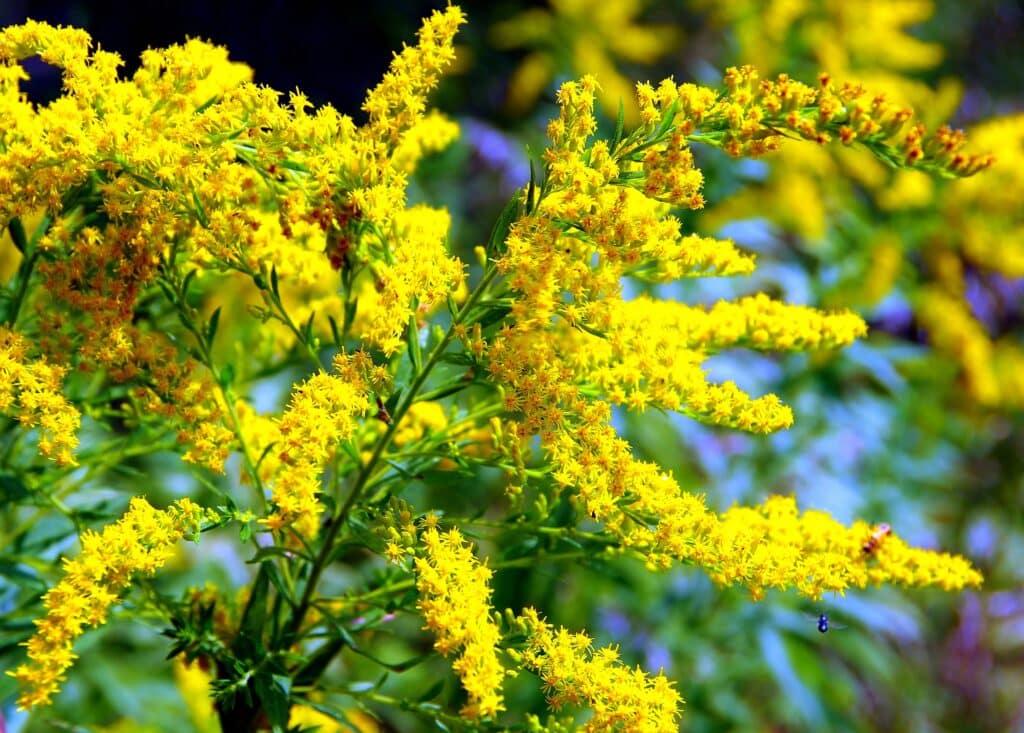Goldenrod For Allergy Relief: How Effective?

We hunt for natural allergy relief as the flowers bloom and the sneezes start. Goldenrod, a plant often mistaken for its allergenic cousin ragweed, has been used traditionally to combat allergy symptoms.
This blog post will explore goldenrod’s effectiveness in providing respite from itchy eyes and runny noses without relying on pharmaceuticals. Discover nature’s remedy as we delve into goldenrod’s potential to ease allergies.
Key Takeaways
-
- Goldenrod and ragweed are different. Ragweed causes allergies, but goldenrod pollen does not fly around much, making it less likely to make you sneeze or have itchy eyes.
-
- Some people think they are allergic to goldenrod but might react because it has stuff like what’s in ragweed or latex. If you’re allergic to those things, be careful with goldenrod.
-
- Drinking tea made from goldenrod could lower swelling and help with allergy symptoms. The plant has been used for a long time to treat health problems.
-
- Goldenrod essential oil may also help when you can’t breathe well because of allergies. But if you use the oil on your skin, mix it with something else first so it won’t irritate your skin.
-
- You can eat goldenrod in food or as a supplement, too. It might help with allergies and give other health benefits.
Goldenrod vs. Ragweed: Understanding the Difference

Goldenrod and ragweed are often mistaken for each other but differ in their pollen types and allergen descriptions. Understanding these two plants’ differences is crucial for allergy sufferers to manage their symptoms effectively.
Types of pollen
There are different kinds of pollen that plants make. Some pollen is big and sticky, and insects like bees carry it from one flower to another. Goldenrods do this; their heavy pollen does not go far in the air because it’s meant for bugs to spread.
Ragweeds, on the other hand, have tiny and lightweight grains of pollen. Their small size lets them ride on even a slight breeze, traveling far away from the parent plant. This ragweed pollen easily gets into people’s noses and eyes, which can cause sneezing, runny noses, or itchy eyes in many who are allergic to it – about 75 percent of Americans with pollen allergies react to ragweed.
Ragweed is known as a major bad guy during allergy season because billions of small grains get around so much. Meanwhile, goldenrod gets blamed unfairly since they bloom simultaneously as ragweed but don’t bother most folks’ allergies.
Since goldenrod flowers rely on insects instead of wind to spread their large and heavy pollen grains, you’re less likely to breathe them in than those pesky ragweed particles that float through the air.
Allergen description
Goldenrod and ragweed have different types of pollen. Goldenrod pollen is large and sticky, catching a ride on bees and other pollinators who move it from one flower to the next. Goldenrod relies on insects, not wind, to spread its pollen.
Because it doesn’t float through the air much, goldenrod pollen doesn’t often cause allergies.
Ragweed is the real troublemaker for those with hay fever. Its lightweight pollen grains easily catch the wind, traveling far and wide. People breathe in these tiny particles, leading to sneezing, runny noses, or even asthma attacks.
Ragweed flowers grow in clusters; they’re less showy than goldenrod’s yellow blooms but pack millions of pollen grains that trigger allergies during late summer into fall.
Potential cross-reactivity
Sometimes, people allergic to some plants might also react to goldenrod. This happens because goldenrod has proteins similar to those in other plants like ragweed, marigolds, and even natural rubber latex.
You may have heard that touching or being near these plants can cause itchy skin or a rash. That’s called contact dermatitis; some folks get it from Goldenrod, too.
If you’re sensitive to latex, be careful with goldenrod. The pollen from this plant can act like latex and make allergies worse. Scientists know something in both goldenrod and latex makes this happen.
They call this cross-sensitization because the body sees them as the same thing and can react to both.
Exploring the Benefits of Goldenrod for Allergy Relief

Goldenrod has a long history of use for medicinal purposes and is believed to have anti-inflammatory properties that can help reduce allergy symptoms. Scientific evidence supports the potential benefits of goldenrod for allergy relief, making it a natural alternative worth exploring.
Historical use of goldenrod for medicinal purposes
Goldenrod has a long history as an herbal remedy for various health concerns. Traditional medicine has been used to treat skin wounds and urinary conditions. It’s also been a part of German folk medicine for addressing issues like kidney stones, urinary retention, and hemorrhoids.
Additionally, goldenrod has been consumed as an herbal tea or dietary supplement to ease inflammation and support urinary system health.
The historical use of goldenrod demonstrates its versatility in addressing different health needs over the years. Its application in traditional medicine for healing wounds and maintaining urinary wellness showcases its potential as a natural remedy with multiple beneficial properties.
Scientific evidence supporting the use of goldenrod for allergies
Scientific evidence for the effectiveness of goldenrod in managing allergies is limited. Most studies have been conducted on animals, and there is no strong evidence from human trials.
While some early research suggests potential benefits, it’s important to note that this data should be interpreted cautiously due to its preliminary nature. Additionally, individuals should be aware that allergic reactions to goldenrod are possible, which may present as skin rashes or asthma symptoms in susceptible individuals.
Given the scarcity of robust scientific support, it’s crucial to approach the use of goldenrod for allergy relief with a cautious mindset. The existing evidence primarily stems from animal studies, and human trials are limited.
Furthermore, it’s essential to recognize that while some people may benefit from goldenrod, others might experience adverse reactions such as skin rashes or exacerbated asthma symptoms.
How goldenrod helps to reduce inflammation and relieve allergy symptoms
Goldenrod has anti-inflammatory properties that can help reduce pain and swelling. It contains beneficial chemicals such as saponins, contributing to its anti-inflammatory effects.
Studies have shown that goldenrod may help relieve inflammation and reduce seasonal allergy symptoms. Additionally, it can ease upper respiratory congestion caused by allergies, sinusitis, and flu.
Goldenrod is a potential natural alternative for allergy relief and improving overall health.
Practical Ways to Incorporate Goldenrod for Allergy Relief
Incorporate goldenrod for allergy relief by drinking goldenrod tea, using goldenrod essential oil, and adding goldenrod to your diet. Read on to discover how these methods can help alleviate allergy symptoms.
Drinking goldenrod tea
Goldenrod tea has been used for centuries as a natural remedy for allergies and inflammation. This herbal tea is believed to have anti-inflammatory properties, which can help reduce the symptoms of seasonal allergies.
It has also been traditionally used to alleviate sinus infections, colds, and urinary tract infections due to its potential medicinal benefits in treating these conditions. Incorporating goldenrod tea into your daily routine may relieve allergy-related discomfort and support overall immune health.
Studies suggest that drinking goldenrod tea could aid in reducing inflammation and easing allergic reactions. The historical use of goldenrod for medicinal purposes further supports its potential effectiveness in relieving allergies.
Using goldenrod essential oil
Goldenrod essential oil is a powerful tool for combating allergy symptoms. It is effective in relieving upper respiratory inflammation and congestion, providing much-needed relief during allergy season.
This natural remedy can also benefit individuals with sinus congestion and flu symptoms. Incorporating goldenrod essential oil into your wellness routine may help alleviate the discomfort associated with allergies and seasonal respiratory issues.
Keep in mind that using goldenrod essential oil should be done with care. Dilute it properly before applying it to the skin, as direct contact may irritate some individuals.
Adding goldenrod to your diet
Consider adding goldenrod to your diet to reap its benefits for allergy relief. Goldenrod supplies beneficial plant compounds like saponins and flavonoid antioxidants, which can help combat allergy symptoms.
You can incorporate goldenrod into your diet by using it in teas, as a seasoning in food, or even consuming it as a supplement. These simple additions may aid in alleviating allergy discomfort and supporting overall well-being.
Goldenrod provides an alternative option for addressing allergies while offering potential health advantages through its consumption. Integrating this natural remedy into your daily routine may contribute to managing allergy-related issues and promoting better health outcomes.
Goldenrod as a Natural Alternative for Allergy Relief.
Goldenrod is a natural decongestant, easing upper respiratory congestion from allergies, sinusitis, and flu. It has been found effective in 11 human studies as part of the product Phytodolor.
Goldenrod also has traditional uses for allergies, colds, and flu. Some practical ways to incorporate Goldenrod into your allergy relief routine include drinking tea, using an essential oil, and adding Goldenrod to your diet.
FAQs
Q: What is the difference between goldenrod and ragweed?
A: Goldenrod is a species of flowering plant in the genus Solidago, known for its yellow flowers. Conversely, ragweed is a plant species commonly responsible for causing allergies, particularly hay fever.
Q: Are people allergic to goldenrod or ragweed?
A: People are more commonly allergic to ragweed, as it is known for causing allergic reactions in individuals with ragweed allergies. Despite often being blamed for allergies, Goldenrod is not a common cause of allergic reactions.
Q: When does goldenrod typically bloom?
A: Goldenrod plants usually bloom from late August to September, whereas ragweed tends to release its pollen around the same time, causing seasonal allergies for many individuals.
Q: Can goldenrod pollen cause allergies?
A: While goldenrod produces pollen, the likelihood of it causing allergies is relatively low. Goldenrod pollen is heavy and sticky, designed for insect pollination, while ragweed pollen is light and easily wind-dispersed, leading to allergic reactions in susceptible individuals.
Q: How effective is goldenrod for allergy relief?
A: Goldenrod is not typically effective for alleviating allergy symptoms caused by ragweed allergies. It is important to consult a healthcare professional for appropriate allergy relief and management.
Q: Why is goldenrod often blamed for causing allergies?
A: Goldenrod is often mistakenly blamed for causing allergies due to its bloom time coinciding with ragweed and its bright yellow flowers being mistaken for the culprit of allergy symptoms. However, goldenrod is not a significant allergen for most people.
Q: What are some common terms associated with ragweed allergies?
A: Common terms associated with ragweed allergies include ambrosia, wind-pollinated, Ige, billion pollen grains, and allergic to ragweed, among others.
Q: Do goldenrod and ragweed belong to the same plant family?
A: While goldenrod and ragweed are often found together and mistaken for each other, they do not belong to the same plant family. Goldenrod belongs to the Asteraceae family, while ragweed belongs to the genus Ambrosia.
Q: Can goldenrod be beneficial for pollinators despite its association with allergies?
A: Yes, goldenrod can benefit pollinators such as bees and butterflies due to its nectar-rich flowers, despite its unfortunate association with allergies in some individuals.
Q: What are some key characteristics of ragweed allergies?
A: Ragweed allergies are characterized by sneezing, runny or stuffy nose, itchy throat, and red, watery, and swollen eyes. Consult a healthcare professional for accurate diagnosis and treatment of allergies.

